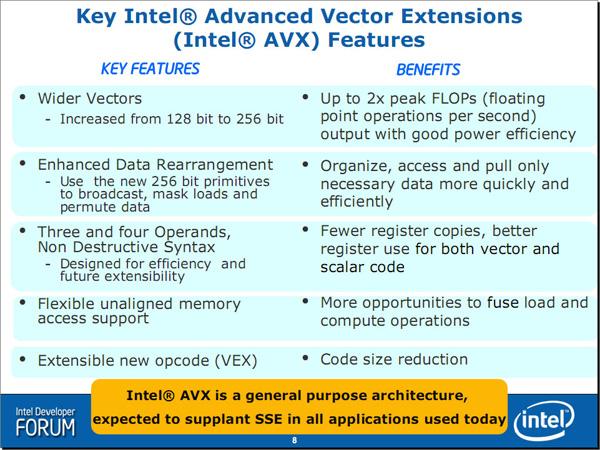With Intel's Developer Forum just days away, an apparently leaked presentation for the event indicates where the chipmaker's processors are headed over the course of the next four years.
It's here, however, that the presentation veers into largely unfamiliar territory. Apart from planning a chip die shrink to 32 nanometers for i7 due later in 2009, known as Westmere, Intel's next big change in architecture is now set to take place in 2010 with a technology known as Sandy Bridge.
While lightly discussed in the past, Sandy Bridge is now said to focus heavily on vector math — an important component to certain 3D and movie operations and once the strongest selling point of PowerPC-based Macs. The processor design will introduce support for new programming features known as Advanced Vector Extensions, or AVX, which will not only be much more complex with 256 bits of data versus 128 for today's SSE equivalents but will support as many as three or four calculations in one instruction depending on the task at hand.
The overhaul of Intel's chip design will also be built with the capability to handle at least eight cores on a single chip and will have much less Level 2 memory cache than today, at just 512KB per core, in return for 16MB of Level 3 to be distributed among all the cores. This architecture will be shrunk sometime in 2011 when it's known as Ivy Bridge, according to Intel.
For future processors, the Santa Clara, Calif.-based company has less detail but vows a breakthrough at least as significant as Sandy Bridge. Nicknamed Haswell, it will have "revolutionary" power management, an all-new approach to caching, and the option of dedicated vector coprocessors in a package separate from the main processor. It will also be the first Intel chip to support Fused Multiply-Add instructions that, as the name suggests, include math with both additions and multiplications in a lone instruction.
Intel isn't expected to confirm at least some of these details for either Sandy Bridge or Haswell ahead of the Developer Forum, which starts August 19th in San Francisco. With both processor generations not due for at least another two years, though, the presentations made at the event will, for now, be the best look at where mainstream computers will be in the future.
 Katie Marsal
Katie Marsal







-m.jpg)






 Andrew Orr
Andrew Orr
 Malcolm Owen
Malcolm Owen
 William Gallagher
William Gallagher

 Wesley Hilliard
Wesley Hilliard





-m.jpg)




15 Comments
I should really stop keeping up with all of this future hardware information. Since i am always thinking of what is coming next, I feel bad buying the current products.
I should really stop keeping up with all of this future hardware information. Since i am always thinking of what is coming next, I feel bad buying the current products.
I could care less about Sandy Bridge or Ivy Bridge right now. I've got myself on a schedule. I bought a Core2Duo 17" MacBook Pro (which was nice because of the 64-bit processor, but I have a 32-bit chipset) and my next 17" MacBook Pro will be next year with Nehalem. It'll be time for an upgrade and it'll be a good upgrade at that. After that, my next 17" MBP won't probably be until 2012, so I'm more interested in Haswell.
Intel has a tick-tock format to their architecture, so there is one big upgrade (Sandy Bridge) and then a small upgrade (Ivy Bridge). Just upgrade when you need it and then build a timeframe after that, there is always something better coming out.
While it's nice to see the future Intel roadmap, one has to live in the moment. The stuff is good right now. If you wait for the next best thing, you'll always be waiting! Although, since new MacBook Pros are imminent, some may wish to wait the short period of time until they surface.
I should really stop keeping up with all of this future hardware information. Since i am always thinking of what is coming next, I feel bad buying the current products.
This is a pretty stupid attitude. I like it when new things come out, even if I bought a new machine not long ago. It means when I buy a new one I'll be getting something better that has the bugs ironed out. I buy new machine every 18-24 months and sell the old one. It's a bit more expensive this way, but if you can't afford it, then you shouldn't be in the market or care. If you just want the latest and greatest (no matter how buggy or how long you have to wait in line for) then you should just go get your head checked.
I could care less about Sandy Bridge or Ivy Bridge right now. I've got myself on a schedule. I bought a Core2Duo 17" MacBook Pro (which was nice because of the 64-bit processor, but I have a 32-bit chipset) and my next 17" MacBook Pro will be next year with Nehalem. It'll be time for an upgrade and it'll be a good upgrade at that. After that, my next 17" MBP won't probably be until 2012, so I'm more interested in Haswell.
Intel has a tick-tock format to their architecture, so there is one big upgrade (Sandy Bridge) and then a small upgrade (Ivy Bridge). Just upgrade when you need it and then build a timeframe after that, there is always something better coming out.
Also it's all just vapourware. God knows what they will actually bring out and when. Wait until it's sitting on the shelf, or at least announced.